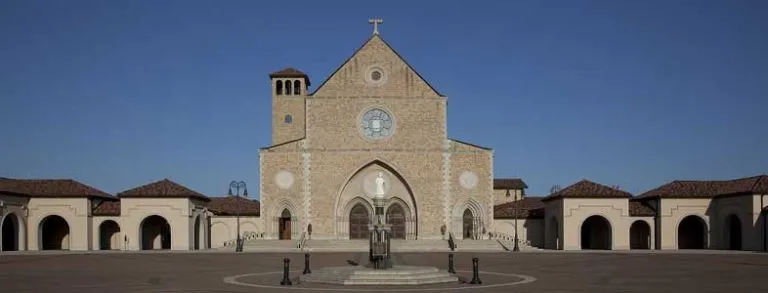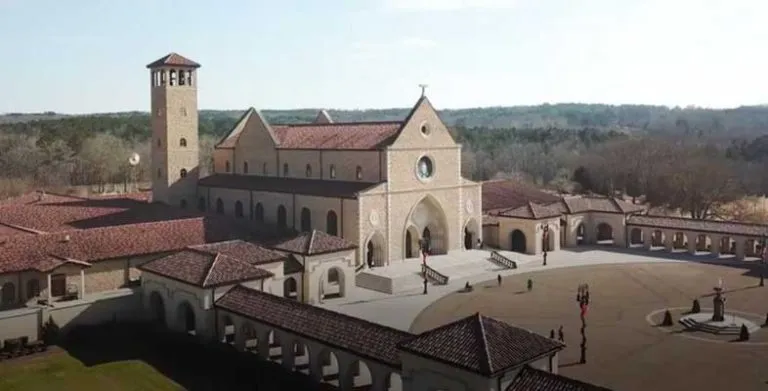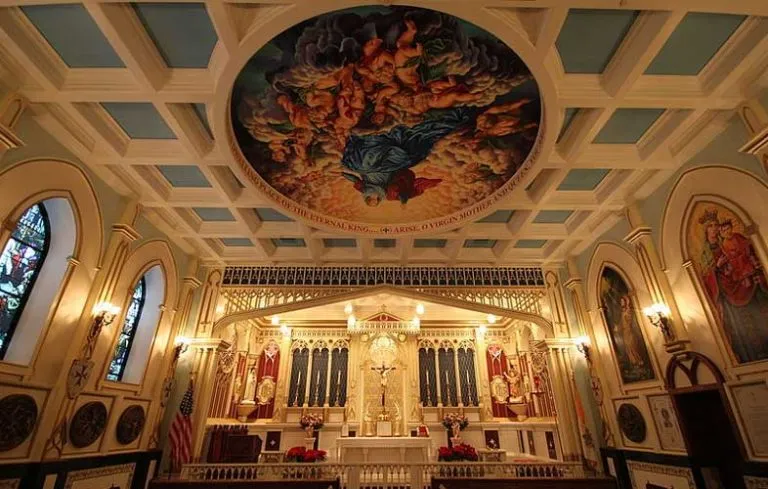
Introduction
The Shrine of the Most Blessed Sacrament, Hanceville of Our Lady of the Angels Monastery, informally known as OLAM Shrine, is a prominent Roman Catholic Latin Rite shrine located in Hanceville, Alabama, United States within the Diocese of Birmingham. Adjacent is the cloistered Monastery of the Poor Clare Nuns of Perpetual Adoration, situated on a 400-acre (160 ha) site and a religious center affiliated with the Eternal Word Television Network.
In 1961, Mother Angelica, a Poor Clare nun from Canton, Ohio, came to Irondale, Alabama with four other nuns in order to establish a new monastery. Twenty years later, having seen the potential to reach many souls throughout the world with the Gospel of Jesus Christ by means of electronic media, she founded the Eternal Word Television Network. This network grew from a small studio in the monastery garage to become the largest religious media network in the world. As a result of such incredible growth, Mother sensed the need to re-establish the contemplative religious life of the nuns away from the busyness of the network. Upon visiting the Sanctuary of the Divine Jesus in Bogota, Columbia, she was inspired to build a resplendent temple of worship for the Lord. Construction was completed in three and a half years and the Shrine was dedicated on 19th December, 1999.
The Shrine is notable for its gilt interior, solemn atmosphere, and 7.5-foot (2.3 m) monstrance. The Shrine is named in honor of the Most Blessed Sacrament, while the building surroundings are dedicated to the Divino Nino, a title of the Child Jesus found prominently displayed all over the area. Its foundress, Mother Mary Angelica of the Annunciation, resided at the cloistered monastery with her nuns until her death in 2016.
Visitors to the Olam Shrine of the Most Blessed Sacrament (also called Ewtn shrine) are struck by its beauty and grandeur, often commenting on the atmosphere of peace that pervades the grounds and the ethos of prayer and reverence exuded by everything from the artwork to the architecture.
History of Shrine of Most Blessed Sacrament, Hanceville


The Shrine of the Most Blessed Sacrament in Hanceville, Alabama, stands as a testament to the vision and faith of Mother Angelica, the founder of the EWTN Global Catholic Network. The origins of this awe-inspiring sanctuary trace back to a profound encounter Mother Angelica had during her travels in Bogotá, Colombia, over five years ago.
It was there, in a moment of prayer, that Mother Angelica experienced a mystical encounter with a statue of a young Jesus, who implored her to “Build me a temple and I will help those who help you.” This divine encounter ignited a fervent determination within Mother Angelica to fulfill this celestial commandment upon her return to Alabama.
Upon her return, Mother Angelica embarked on a quest to find suitable land for the construction of this temple. Despite initial challenges, she discovered over 300 acres of land owned by a non-Catholic family, who were moved by her sincere desire to build a temple for Jesus. Their generous response paved the way for the realization of Mother Angelica’s vision.
Construction of the temple commenced under the guidance of Brice Construction of Birmingham, with over 200 workers, the majority of whom were not Catholic. The architectural design mirrored the grandeur of 13th-century structures, incorporating elements such as marble, gold, and cedar, reminiscent of the Temple of David described in the Bible.
Materials were sourced from various corners of the globe, including ceramic tile from South America, stones from Canada, bronze from Madrid, Spain, and wood from cedar imported from Paraguay. Skilled artisans crafted intricate details, such as hand-carved Stations of the Cross and stained glass windows imported from Munich, Germany.

Materials were sourced from various corners of the globe, including ceramic tile from South America, stones from Canada, bronze from Madrid, Spain, and wood from cedar imported from Paraguay. Skilled artisans crafted intricate details, such as hand-carved Stations of the Cross and stained glass windows imported from Munich, Germany.
Central to the shrine’s purpose is perpetual adoration of the Blessed Sacrament, with cloistered nuns dedicated to prayer and worship around the clock. Their commitment to silence, solitude, and prayer forms the spiritual foundation upon which the shrine stands. Requests for prayer pour in from around the world, testifying to the shrine’s significance as a beacon of faith and hope.
The shrine’s interior, adorned with a striking gold leaf wall, serves as a sanctuary for intimate communion with the divine. Behind this golden veil, two nuns maintain perpetual prayer vigil, interceding for the needs of humanity.
The shrine’s exterior is crowned by a cross, bearing a profound significance. Despite being damaged in a storm, the cross remained standing, its shape resembling the Hebrew letter “T,” symbolizing”God Among Us.” Mother Angelica interpreted this event as a sign of divine favor and protection, choosing to preserve the cross as a testament to God’s presence.
Through the generosity of anonymous donors and the unwavering dedication of Mother Angelica and her supporters, the Shrine of the Most Blessed Sacrament stands as a beacon of faith, offering solace and inspiration to all who seek communion with the divine.


Mother Angelica
Mother Angelica was born Rita Antoinette Rizzo on 20th April, 1923, in Canton, Ohio. She was the only daughter of John and Mae Helen Gianfrancisco Rizzo. Her childhood was hard. Her Catholic parents were divorced when she was six years old. She endured poverty, illness, and hard work and never really knew the carefree times of childhood. She lived with her mother and began working at an early age, assisting her mother in her dry cleaning business. She was scorned by the nuns and her classmates, not only because of her poverty but because her parents were divorced. Rita eventually left the Catholic school and attended public school instead.
Rita did poorly in school. She had little time for homework, no friends, and no social life. She found strength and solace in reading the scriptures, primarily the Psalms. The first miracle of Rita’s life came when she was a young school girl walking downtown. As she crossed a busy street, she heard a shrill scream and saw headlights of a car coming at her with great speed. There was no time to react. A moment later, she found herself on the sidewalk. She said it was as though two strong hands had lifted her to safety.
Rita experienced severe stomach pains for many years. She didn’t want to worry her mother and hid them from her. Finally, she had to go to the doctor. She was diagnosed with severe calcium deficiency. Her mother had heard of a woman who had been miraculously healed by Jesus. She took Rita to see Rhoda Wise and have her prayer over her. Mother Angelica sees that as a pivotal point in her life. After nine days of prayer and asking the intercession of St. Therese, known as the Little Flower, Rita was healed. She began to pray at every opportunity, oblivious to things going on around her. After work, she’d go to St. Anthony’s church and pray the stations of the cross.
In the summer of 1944, while praying in the church, she had the “unquestioning knowledge” that she was to be a nun. She had a hardy dislike of nuns from her early school years and at first, could not believe it. She sought her pastor and he confirmed that he had seen God working in her life and urged her to be obedient to God’s special call. She first visited the Josephite Sisters in Buffalo. The nuns welcomed her and talked with her. After getting to know her, they felt she was better suited for a more contemplative order. On 15th August, 1944, Rita entered St. Paul’s Shrine of Perpetual Adoration in Cleveland. She sent the news to her mother by registered mail, knowing that it would upset her.
On 8th November, 1943, Rita’s mother went to her investment ceremony–her wedding day to Jesus. Mae Rizzo was given the honor and privilege of selecting Sister Rita’s new name: Sister Mary Angelica of the Annunciation.
In 1946, when a new monastery was to be opened in Canton, Ohio, Sister Angelica was asked to move there and help with it. She would once again be near her mother. The pain and swelling in her knees, which had concerned the nuns about her ability to receive first vows, disappeared on the day she left Cleveland for Canton.
After suffering from a fall and ending up in the hospital and unable to walk, Sister Angelica faced the possibility of never walking again. She cried out to God, “You didn’t bring me this far just to lay me out on my back for life. Please, Lord Jesus, if you allow me to walk again, I will build a monastery for your glory. And I will build it in the South.”
Mother Angelica and some of the other sisters of Santa Clara devised money-making schemes to pay for this new monastery in the South–the Bible Belt, where Baptists were the majority and Catholics were only 2 percent of the population. One project that proved profitable was making fishing lures. On 20th May, 1962, the Irondale, Alabama community of cloistered nuns dedicated Our Lady of the Angels Monastery. After founding the EWTN Global Catholic Network, writing many books, and sharing her knowledge around the world, Mother Angelica build the Shrine of the Most Blessed Sacrament, Hanceville and moved the community to the Hanceville, Alabama Monastery in December 1999.
Architecture


St. Peter Julian Eymard (1811 to 1868), of France, had a strong devotion to the Holy Eucharist and Our Lady and began his priestly life in the Society of Mary. “But his heart burned with the desire to establish perpetual adoration of Jesus in the Blessed Sacrament exposed upon a royal throne and surrounded by a large court of adorers.” On 2 February 1851, at the shrine of Fourviere, the most Blessed Virgin had made him understand its necessity. ‘All the mysteries of my Son have a religious order of men to honour them. The Eucharist alone has none’.
The Olam Shrine itself, both church and monastery, are modelled on the great Italian churches of the 13th century, the time period that experienced the birth of the Franciscan charism.
The piazza through which pilgrims walk before entering the sanctuary itself is a standard of Italian sacred architecture, allowing the faithful time and space in which to recollect themselves interiorly and exteriorly in preparation for the experience of prayer and sacred liturgy.
The piazza separates the sanctuary symbolically and in reality from the world around it, effectively creating an island of quiet reverence amidst the bustle of the world.
At the doors of the church, pilgrims are greeted with scenes of the Seven Joys and Sorrows of the Virgin Mary, reminding all who enter that she is the vessel through which God entered incarnate into His creation.

Feast Day – 13th May
Annual Feast of Our Lady of the Most Blessed Sacrament held on 13th May.
Shrine - Attractions Nearby
Mass Time
Weekdays
Tuesdays & Saturdays
Sundays
Church Visiting Time
Contact Info
Shrine of the Most Blessed Sacrament,
3224, County Road, 548, Hanceville,
35077, Alabama, AL, United States.
Phone No.
Tel : +1 256-352-6267
Accommodations
How to reach the Shrine
Birmingham–Shuttlesworth International Airport (BHM) is located at Hanceville, Alabama, United States is the nearby airport to the Shrine.
Birmingham Train Station in Birmingham, Alabama, United States is the nearby Train Station to the Shrine.









